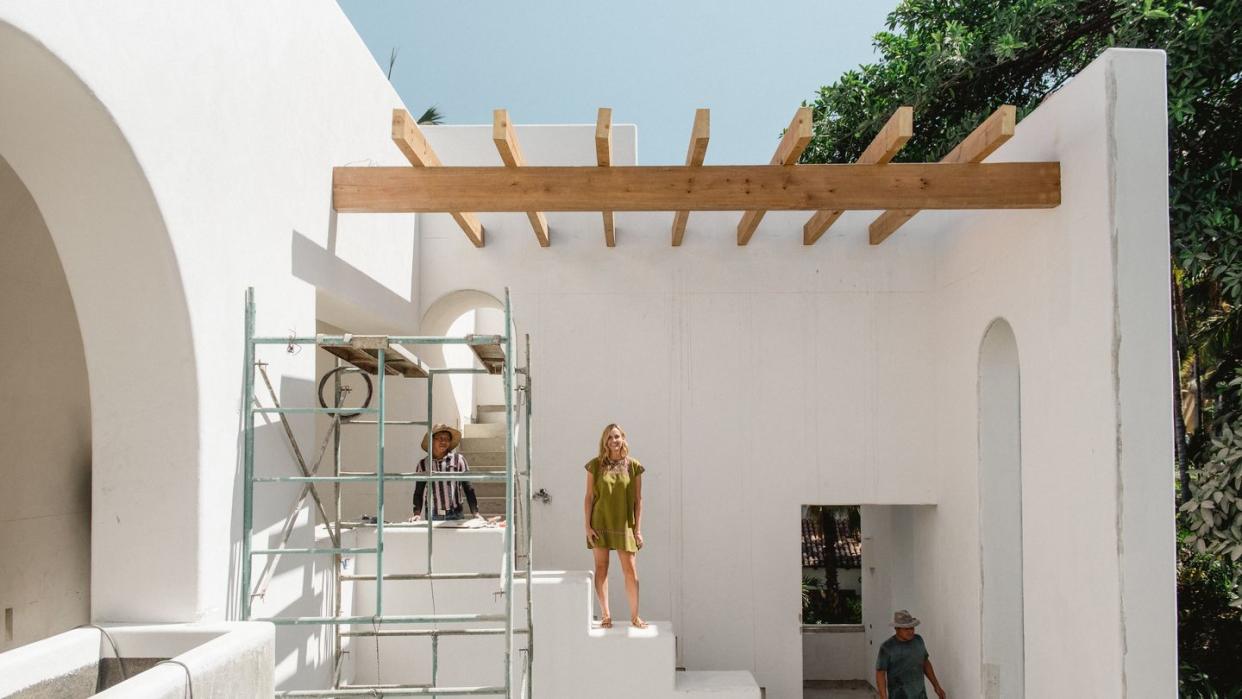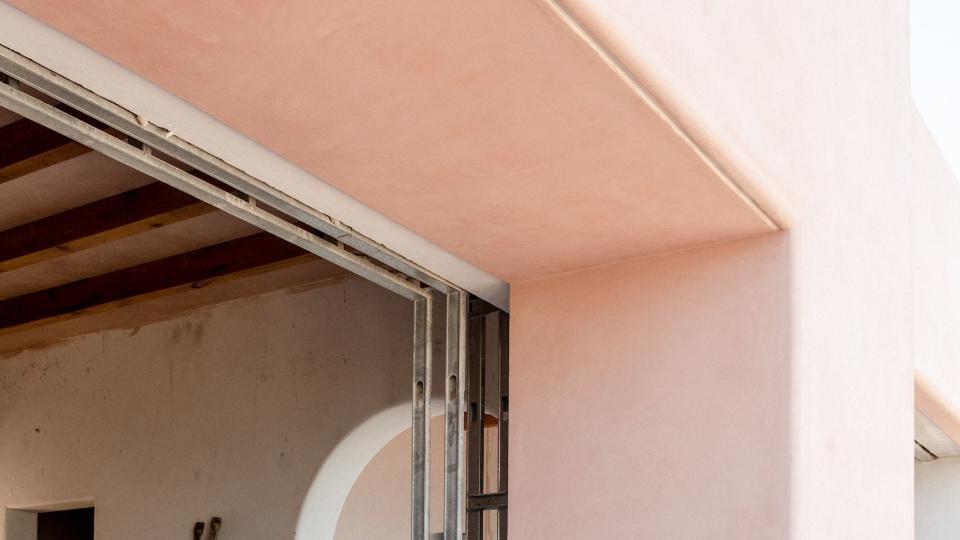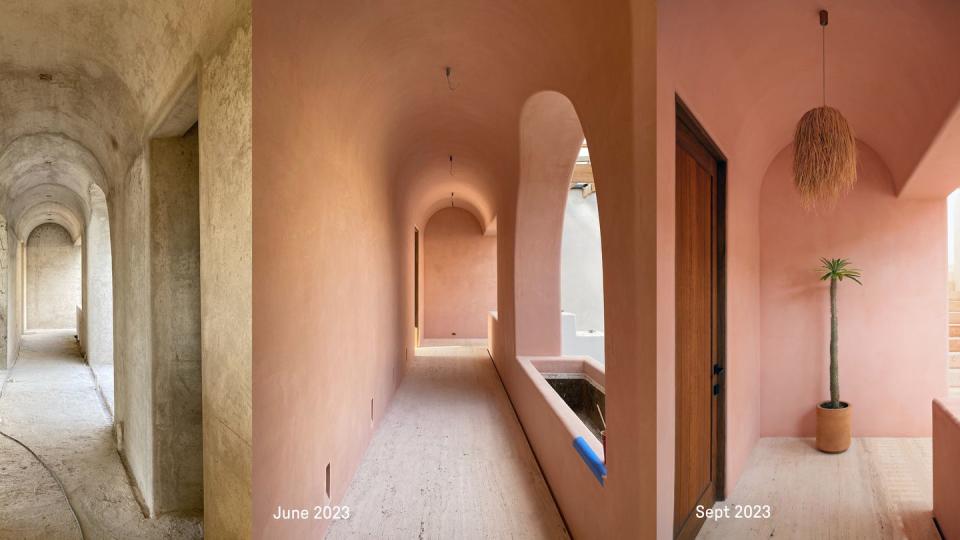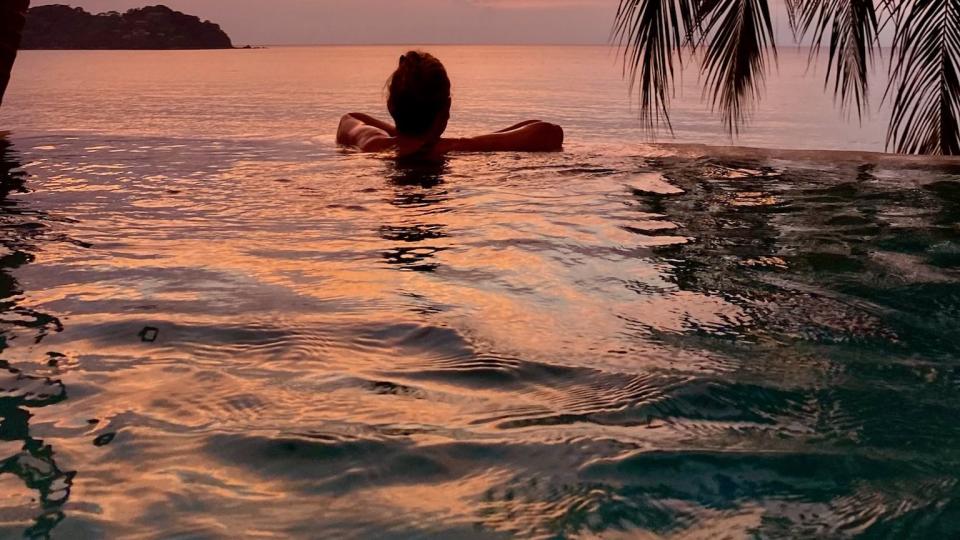How Designer Summer Thornton Built a Fortress of Beauty on the Ocean

VERANDA presents: Designing the Dream with Summer Thornton. In this series, she'll walk us through her step-by-step process of building and designing Casa Rosada, her new home in Sayulita, Mexico. Here's how she added thoughtful details to the home's construction.
I love that stage in a house-building project when the framing is complete. Walking from one room to the next, you almost feel like a ghost spying on your future life—you can imagine what it will be like when the walls are in place, and you can move through your daily routine, flipping on lights and opening blinds.
Sometimes during construction, doorway openings and walkways come down to inches—and during this framing stage, you can make the decision to shift walls or do things like alter the location of your lighting.
But here’s the thing about building in Sayulita: Homes are set in concrete. Casa Rosada is right on the ocean, after all.
This probably goes without saying, but when a house is set in concrete, you don’t have the luxury of moving walls during the framing stage. That means it’s more important than ever to plan every detail from the start. If you’re building in the tropics, read on for a few guidelines we’ve learned from our experience.
Measure twice, build once.

When you interview builders and check their references, remember the importance of detail and precision. If you live thousands of miles away, it won’t be as easy to double-check their work.
I was very nervous during our first Casa Rosada site visit, but I have to give all the credit to our builder, Juan, and architect, Enrique Garcia. A term called “as-built” measurements is pretty standard in construction, where you have the “plan” measurements and then you have what actually happened once the frame was set—oftentimes with discrepancies of varying proportions. These discrepancies can impact everything from furniture and lighting plans to closet sizes.
When I asked Juan for the as-built measurements, he looked at me like I was out of my mind. He said, ‘It will be within an inch.’ And it was.
Rely on ancient techniques that stand the test of time.
I love colors and patterns. My designs are known for layering and an abundant use of wallpaper. But wallpaper would never survive a week in this open-air environment. So rather than fight against the natural environment, I sought ways to make it work for us.
To create depth and texture on the walls, and found an ancient Mayan plaster called chukum that’s made from a mixture of tree sap & limestone powder. Chukum is applied on top of the concrete as a plaster paste. Not only is it waterproof once it dries, but it also withstands salt spray and has a beautiful patina over time. It’s just as durable as it is beautiful.
Naturally, chukum’s finish has a lot of texture and is a warm creamy flax or natural linen color. But I’m putting a spin on it by mixing in color pigment. Most of the house is a soft peachy pink—we’re calling it “Casa Rosada pink”—but we’ve used chukum in its natural rich color in the flex room, a dusty rose in the sunset bedroom, and a pale agave blue in the double bedroom.
Who needs wallpaper when you’ve got an ancient material, like chukum, that lasts hundreds of years? And don’t worry, I’m still a maximalist—I’ve asked local artists to hand-paint some murals in a couple of rooms to add even more pattern and whimsy.
Remember that perfection takes time.

In many rooms throughout the house, we’ve used Mexican travertine slabs on the floors. Even though we sourced it locally, it took us forever to find the right travertine in the quantity and color we needed.
We needed several thousand square feet, all in slabs, so it was a huge order. Because it was going on the floor throughout the house, the color had to be consistent. I wanted it to be super pale, without feeling yellow or brown. We ended up finding the perfect match, but it took several months to find a quarry that offered a good fit. Better to do it right than to do it twice.
Lighten the load.
Casa Rosada’s proportions are quite dramatic. It’s often hard to understand from photos or an illustration, but the living room is 40 by 20 feet—it’s a huge space, so naturally, the ceiling is, too. That’s a long span without wall support, and you can imagine how heavy it gets, especially because it’s built out of concrete. The vision for that space was to feel breezy and airy, so having support columns in the middle would ruin that feeling. Thank God for structural engineers!
To make the ceilings lighter but still structurally sound, we started with a concrete, steel, and rebar web structure and then filled it in with Styrofoam blocks. Yes, Styrofoam! It reduced the weight of the ceiling without compromising strength. Who knew engineering (and Styrofoam) could be so aesthetically pleasing!
Work with your environment.

Typically, temperatures in Sayulita are remarkably pleasant, with highs between 70 to 80 degrees during the day and lows dipping into the 60s at night. For that reason—and the fact that air conditioning is astronomically expensive (we talked to one homeowner who reported paying over $10,000 in a month!)—most homes in Sayulita are open-air and have very little or no air conditioning.
I love that idea. But we want our guests to be comfortable even on warmer days, and we realize that in the kitchen and bedrooms, climate control is helpful for staying comfortable when you’re not wearing a swimsuit by the pool. So our solution involved a two-prong approach.
First, we turned to solar panels to save energy and cut down on utility costs. In the past, when we’d explored solar panels for our Chicago residence, there wasn’t enough sun to make it a worthwhile investment. But in Sayulita, where 340+ days a year are sunny, it’s a definite benefit. We covered half of Casa Rosada’s roof in solar panels. It’s great for the environment and helps keep cooling costs down, too.
Second, we focused on cross-breeze air flow in every room. The secret to a sea breeze is that it flows through the room, with an entry (ocean-side) and an exit (land-side) to draw air through the space. In nearly every room in the house, we’ve created this flow, which allows the house to feel cool simply from the ocean breeze!
Hide distractions, and focus on the beauty.
I don’t like distractions from the mood or feeling of a space. That’s especially true when I’m sitting by the ocean—I don’t want anything to take away from that tranquility. To me, mechanical systems and technology are a necessity but a distraction that should be thoughtfully out of sight.
As an example, for most of our projects, you rarely see air duct returns because we design them to be placed behind a piece of furniture, out of sight. But at Casa Rosada, we don’t have central air, and in much of Mexico, particularly in Sayulita, mini-splits are the typical air conditioning unit of choice. Highly functional and efficient, but an eye sore. We couldn’t have that.
So we hid condensers in ceilings and created returns with a tiny one-inch reveal between the ceiling and the wall. The result is a seamless, nearly invisible aesthetic. You can hardly see it; it just looks like a shadow line. To say this was easy would be a lie, but all the effort was worth it.
The same sort of painstaking detail also went into designing the drains for Casa Rosada as well. Rather than using visible metal drain grates, we gave the floors an ever-so-slight pitch and created a thin reveal drain at the edge of the wall. You can hardly see it, and instead you’re able to focus on the beauty surrounding you.
In combination with the home’s big, open windows that welcome ocean breezes and tall ceilings, these features keep Casa Rosada looking—and feeling—like a dream!
You Might Also Like

